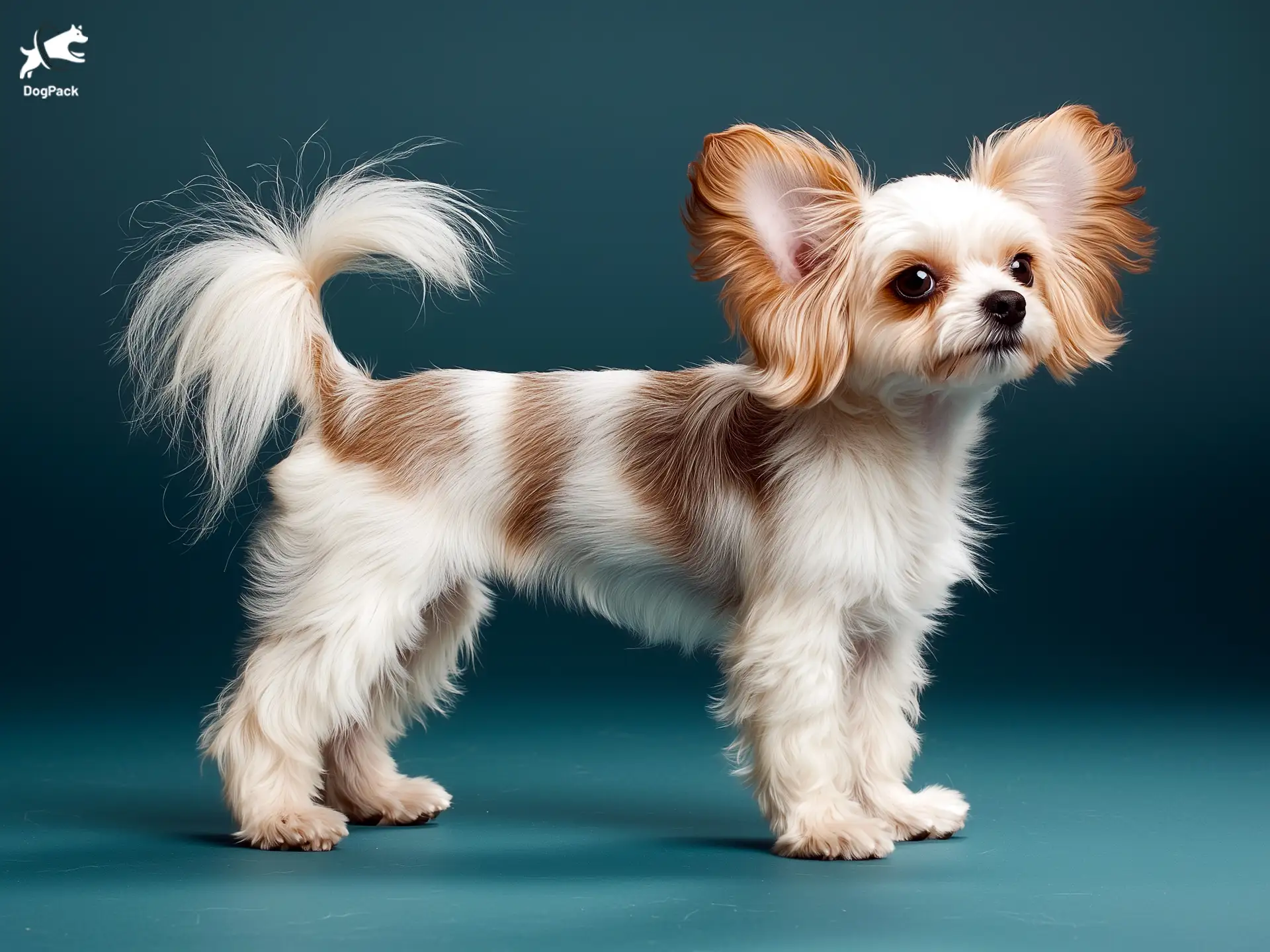Papipoo Dog Breed Info & Overview
Eager to find a pint-sized bundle of energy that adores lap time as much as fetch? The Papipoo could be your perfect match. With its playful personality, hypoallergenic tendencies, and signature “butterfly” ears, this pup wins hearts in an instant. This charming hybrid is beloved by families and singles alike, thanks to a delightful mix of intelligence and affection.
Characteristics
Pictures
Breed History
This hybrid got its start when breeders sought a small companion that blended the Toy Poodle’s hypoallergenic coat with the Papillon’s butterfly-like ears and lively spirit. While exact records aren’t crystal clear, enthusiasts suggest the Papipoo emerged in the United States within the last few decades as a response to increasing demand for adorable, allergy-friendly mixes.
Early Papipoo litters delighted dog lovers craving a blend of the Papillon’s outgoing nature and the Poodle’s remarkable intelligence. Because Papillons have a storied history tracing back to royal courts in Europe and Poodles bring a background of water retrieving, this crossbreed quickly stood out. Its appealing size and cheerful disposition made it even more desirable.
Although smaller in numbers compared to established purebreds, the Papipoo steadily gained popularity through word-of-mouth and local breeding programs. Devoted fans appreciated its loving temperament and compact size. Over time, more families began to discover how well these pups fit into a variety of living situations, solidifying their place among sought-after small dog breeds.
Temperament, Personality
Expect this hybrid to greet you with a wagging tail and a twinkle in its eye. Papipoos are known for being eager to please, happily joining in family activities and relishing one-on-one time. They typically bond closely with their favorite humans, responding quickly to praise and attention.
Around children, they’re playful yet gentle, making them a solid choice for families. Despite their dainty stature, they’re not overly delicate and can handle respectful interactions with kids. They also tend to get along with other pets, especially if socialized early and given enough space to feel secure.
When meeting strangers, they might show initial caution but often warm up once they sense no threat. With proper exposure and training, Papipoos become social butterflies—much like their Papillon heritage suggests. Some may be a bit vocal, alerting you to visitors or interesting noises, a trait that can be managed with consistent boundaries.
Physical Characteristics
These pups typically stand under a foot tall, sporting delicate legs and a light frame. Their appearance can vary, but the Papipoo often has a slightly rounded head and those signature, fringed ears reminiscent of the Papillon. The eyes are bright, inquisitive, and brimming with warmth, giving them a cheerful expression.
Coat textures run the gamut—from wavy and soft to curly and plush—reflecting the influence of the Poodle parent. Fur colors may range from white and cream to black and brown, occasionally featuring spots or patches that reveal their Papillon side. The size is compact, perfect for those in smaller living spaces like apartments.
Sturdier than many toy-sized breeds, the Papipoo balances grace with resilience. Their dainty paws and feathered tail give them a refined look, yet they’re surprisingly agile. A brisk walk can show off their gentle prance, and because of their modest dimensions, they adapt well to car travel, new environments, or being carried around when necessary.
Health Issues
Like many crossbreeds, Papipoos may inherit health conditions from either parent line, though hybrid vigor can reduce some risks. One potential concern is patellar luxation, where the kneecap slips out of place. Regular checkups with a veterinarian can help catch early signs and prevent complications.
Eye issues, such as progressive retinal atrophy (PRA), might pop up in certain bloodlines. It’s wise to discuss eye testing with breeders or your vet to safeguard your pup’s vision. Additionally, dental care is paramount for small dogs, so schedule routine teeth cleanings to avoid tartar buildup and gum disease.
Though typically sturdy, Papipoos benefit from regular weight checks to avoid obesity, which can stress delicate joints. Ensure they stay active, and consider an annual wellness exam that includes blood work and a thorough physical evaluation. Being proactive about vaccinations and parasite prevention also plays a major role in keeping them healthy throughout their lives.
Grooming Needs
Those who value a tidy home will appreciate the Papipoo’s minimal shedding. While not completely shed-free, they drop far less hair than many other breeds, making them suitable for allergy sufferers. Weekly brushing helps keep tangles in check, especially around the ears and tail where mats can sneak up.
Professional grooming every six to eight weeks is often recommended to maintain a neat appearance, especially if your Papipoo inherits a curlier coat. Trimming around the eyes can prevent fur from obstructing vision, and a tidy paw trim reduces slipping on smooth floors. Baths should be moderate—too frequent bathing can strip natural oils.
Regular nail trimming prevents discomfort and paw injuries. Also, pay attention to ear cleanliness. Because Papipoo ears often have feathery fringe, they can trap debris. Use a vet-approved ear-cleaning solution, especially if you notice redness or excessive wax. Combining these grooming steps with a gentle approach ensures a happy, well-kept companion.
Exercise Requirements
Though small, these pups still need daily activities to channel their upbeat energy. A brisk 20-minute walk or a short play session inside the house can do wonders. Interactive toys, like puzzle feeders, keep them mentally stimulated while also burning off steam.
Keep in mind that the Papipoo isn’t built for marathon hikes, but they’ll thrive on moderate strolls around the neighborhood. Fetch in a secure yard or a brief romp in a dog park can keep them fit. Always supervise outdoor play, especially in areas with bigger dogs or near traffic.
Because of their agile nature, these pups may enjoy low-impact agility courses. Jumping through small hoops or weaving around cones can be fun bonding activities. Just be sure not to overdo it—tiny joints can suffer from excessive strain. Balance physical play with cozy downtime, allowing your dog to rest and recharge.
Training Tips
Papipoos are typically bright and eager to learn, thanks to the Toy Poodle’s intelligence and the Papillon’s responsiveness. Start training with simple commands like “sit” and “stay,” rewarding positive behavior immediately. Consistency is key, and short, frequent sessions prove more effective than extended drills.
Because these dogs are people-oriented, they’re quick to pick up on your tone. Keep a cheerful, encouraging demeanor, and avoid harsh corrections that may cause timidness. Early socialization helps them adapt to strangers, other pets, and busy environments—this is vital for preventing shy or fearful behaviors later on.
Housebreaking can be smooth if you establish a routine and watch for signs they need to go. Crate training is also beneficial, offering a safe haven while you’re away. If you notice any stubborn streak, switch tactics or break down tasks into smaller steps. Overall, patience and a gentle approach tend to yield the best results.
Nutrition, Diet
A Papipoo’s meal plan should be tailored to its smaller size and fairly active metabolism. On average, ¾ to 1¼ cups of high-quality dry kibble per day, split into two meals, can keep them fueled. Look for formulas specifically created for small breeds, as these typically have nutrient-dense bites that are easier to chew.
Since Papipoos can be prone to dental issues, opt for crunchy kibble that helps reduce plaque buildup. Avoid overfeeding with table scraps or treats, as extra weight can strain their joints. If your pup has any known sensitivities, consider limited-ingredient diets or grain-free options under a vet’s guidance.
Puppies often need more frequent feedings—three or four times daily—to sustain steady growth. Gradually shift to adult food around one year, monitoring weight to ensure they’re not packing on extra pounds. Always provide fresh water, and consult your veterinarian for specific dietary adjustments, especially if your dog shows signs of allergies or sensitive digestion.
Adoption, Breeders
If you’re considering a Papipoo, reputable breeders or rescue groups are your best bet. Look for places that conduct health screenings and offer socialized puppies acclimated to home life. Ask about parental health clearances and request a chance to see the pup’s living environment.
Adoption can also be an option, with some dedicated rescue organizations specializing in Papillon mixes or Poodle mixes. Check out resources like Petfinder to locate available dogs in your area. By adopting, you give a deserving pup a second chance while learning about their established temperament.
For those leaning toward a breeder, consider referencing Papipoo’s online communities or recognized clubs. The American Kennel Club offers guidance on ethical breeding standards, though the Papipoo itself isn’t an official AKC breed. A thorough breeder will happily discuss health histories, training tips, and ongoing care, setting you up for a successful journey with your new furry family member.
Family Pet?
Thanks to their adaptable size and gentle demeanor, Papipoos can slot nicely into family life. They relish attention from multiple family members, making them a hit during movie nights or backyard gatherings. Supervision with very young children is still advised, given their petite frames.
As for coexisting with other pets, these dogs are usually quite sociable, especially if introduced properly. They’ll often treat bigger canines or resident cats as buddies, provided there’s no roughhousing. Small, positive interactions encourage harmony, and structured introductions can set the tone for lifelong companionship.
In a family setting, mutual respect is crucial. Teach children to approach gently and let the dog have a safe retreat. When given space, affection, and consistent routines, Papipoos reward families with constant entertainment and unwavering loyalty—just the right recipe for a memorable household companion.
Right For You?
If you live in a compact space but crave an active, social companion, this mix might check all your boxes. Papipoos adapt well to apartment living, provided they get daily interaction and enough mental stimulation. Their minimal shedding and friendly nature make them a prime pick for individuals who prefer a relatively low-maintenance yet engaging pet.
On the other hand, if you’re often away for long periods, consider whether this affectionate dog’s emotional needs will be met. Those seeking a larger, more independent breed might find a Papipoo’s clinginess challenging. Ultimately, your lifestyle should match the dog’s desire for closeness, moderate activity, and gentle guidance.
Ask yourself if you can commit to regular grooming and short exercise sessions. Can you offer daily companionship and monitor for minor health concerns, such as dental or joint issues? If so, a Papipoo may be your ideal match. They bring companionship, charm, and a dash of whimsy to homes that appreciate small but spirited canine pals.
Conclusion
With their delightful blend of charm, intelligence, and modest grooming needs, the Papipoo can be a wonderful fit for those seeking a cuddly companion that’s still game for energetic play. From affectionate snuggles to interactive training sessions, they’re sure to keep life interesting. If you value a close bond with a lovable dog that adapts well to various living situations, this hybrid might just be your perfect pick.
FAQs
-
How does the Papipoo’s intelligence compare to other small breeds?
The Papipoo inherits high intelligence from both the Papillon and Toy Poodle, making it one of the quickest learnersamong small breeds. They excel in trick training, agility, and problem-solving games, often outperforming other toy-sized hybrids in mental challenges.
-
Does the Papipoo retain the butterfly-like ears of the Papillon?
While some Papipoos inherit the large, butterfly-shaped ears of the Papillon, others may develop the floppier, more relaxed ears of the Toy Poodle. The final ear shape can vary depending on genetics, with some dogs having partially upright ears with soft, feathery fur.
-
Is the Papipoo more attached to one person or a social butterfly?
The Papipoo tends to form a deep bond with one primary owner but remains friendly and affectionate toward others. While they can be social, they often display Velcro-dog tendencies, meaning they prefer to be near their favorite human at all times.
-
Can a Papipoo tolerate long periods alone?
Due to their strong attachment to people, Papipoos are prone to separation anxiety. Leaving them alone for extended hours may lead to barking, destructive chewing, or stress behaviors. Interactive toys, a second pet, or a structured routine can help manage their anxiety.
-
How does the Papipoo’s coat vary between litters?
The Papipoo’s coat can be straight like a Papillon’s or curly like a Poodle’s, depending on which parent’s genes dominate. Some have a wavy, medium-length coat that is low-shedding but requires regular grooming to prevent tangles and matting.
Breed Ratings
The Papipoo is quick-witted and adapts well to training exercises, showing problem-solving skills that surprise many owners.
Their lively nature makes them excellent playmates, whether it’s a game of fetch or chasing after soft toys around the living room.
They enjoy bursts of activity but also appreciate lounging on the couch, balancing moderate exercise with downtime.
Low shedding is a hallmark, though regular brushing is essential to keep their soft coat tangle-free.
While they may show mild curiosity, they’re not typically driven to chase small animals, especially if socialized early.
Routine trims and brushing can be time-consuming, but their coat is manageable with consistent upkeep.
Their bright disposition and eagerness to please make them receptive to positive reinforcement methods.
They prefer company and can experience separation anxiety if left alone for lengthy periods.
They’ll announce visitors or novel noises but can learn to limit barking with patience and structure.
Drooling is minimal, keeping them relatively tidy around the home.
Early socialization encourages friendly interactions with other dogs, especially those of similar size.
Generally robust, with a few breed-specific concerns best managed by proactive veterinary care.













